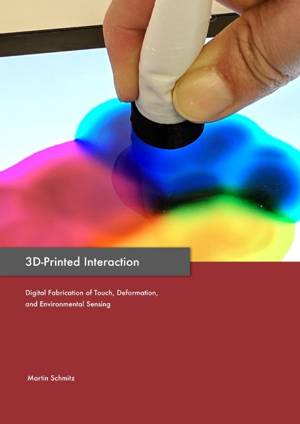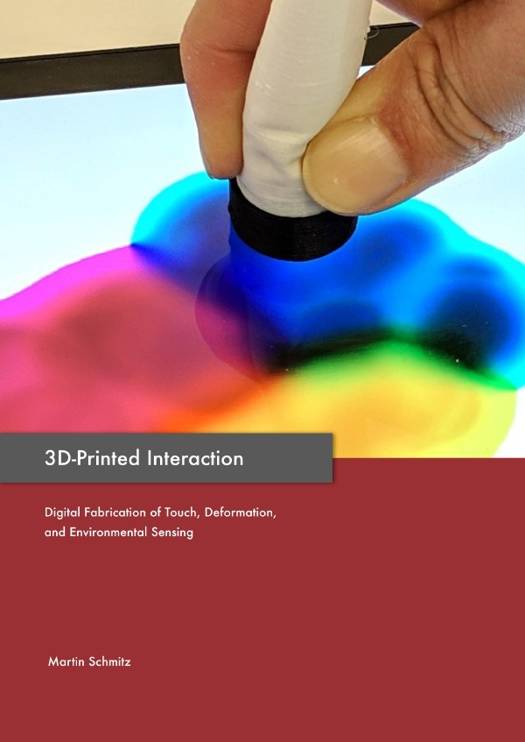
- Afhalen na 1 uur in een winkel met voorraad
- Gratis thuislevering in België vanaf € 30
- Ruim aanbod met 7 miljoen producten
- Afhalen na 1 uur in een winkel met voorraad
- Gratis thuislevering in België vanaf € 30
- Ruim aanbod met 7 miljoen producten
Zoeken
3D-Printed Interaction
Digital Fabrication of Touch, Deformation, and Environmental Sensing
Martin Schmitz
Paperback | Engels
€ 59,45
+ 118 punten
Omschrijving
The progressing digitalization increases the demand for interactive devices that bridge the physical and digital world. While there is great potential for customized interactive devices tailored to specific applications or users, until recently, integrating interactivity in custom devices required pre-defined components (e.g., rectangular buttons or flat touchscreens) that constrains the shape of the device. A more flexible alternative has opened up with the advent of 3D printing which empowers companies, developers, and end users to design and fabricate custom-shaped individual objects on demand with relatively low effort. Even though recognized as revolutionizing the manufacturing process, the 3D printing of custom-made interactive devices still requires novel sensor concepts, that operate on complex geometries, and significant design or assembly effort.
This thesis concerns the 3D printing of interactive input devices that respond to a variety of external stimuli and are printed in a single pass without requiring significant assembly steps. It consists of five major contributions: The first contribution is a fabrication pipeline to design and 3D print custom-shaped touch sensors on complex 3D objects. Then, the second contribution extends the first pipeline to detect hovering, touching, or pressing of a finger on a 3D-printed object. The third contribution continues to explore deformation-aware 3D-printed objects that detect pressure, squeeze, and bending in combination with a capacitive touchscreen. The fourth contribution adds liquid to 3D-printed objects to detect tilting and motion interactions. Based on these liquid-filled objects, the fifth contribution is an alternative sensing approach that does not require powered electronics during the interaction. Instead, each sensor concept memorizes the effect of a pre-defined external stimulus by changes in its internal structure. These changes can be read-out at a later time through a capacitive touchscreen.
This thesis concerns the 3D printing of interactive input devices that respond to a variety of external stimuli and are printed in a single pass without requiring significant assembly steps. It consists of five major contributions: The first contribution is a fabrication pipeline to design and 3D print custom-shaped touch sensors on complex 3D objects. Then, the second contribution extends the first pipeline to detect hovering, touching, or pressing of a finger on a 3D-printed object. The third contribution continues to explore deformation-aware 3D-printed objects that detect pressure, squeeze, and bending in combination with a capacitive touchscreen. The fourth contribution adds liquid to 3D-printed objects to detect tilting and motion interactions. Based on these liquid-filled objects, the fifth contribution is an alternative sensing approach that does not require powered electronics during the interaction. Instead, each sensor concept memorizes the effect of a pre-defined external stimulus by changes in its internal structure. These changes can be read-out at a later time through a capacitive touchscreen.
Specificaties
Betrokkenen
- Auteur(s):
- Uitgeverij:
Inhoud
- Aantal bladzijden:
- 248
- Taal:
- Engels
Eigenschappen
- Productcode (EAN):
- 9783750281622
- Uitvoering:
- Paperback
- Afmetingen:
- 170 mm x 240 mm
- Gewicht:
- 428 g

Alleen bij Standaard Boekhandel
+ 118 punten op je klantenkaart van Standaard Boekhandel
Beoordelingen
We publiceren alleen reviews die voldoen aan de voorwaarden voor reviews. Bekijk onze voorwaarden voor reviews.








